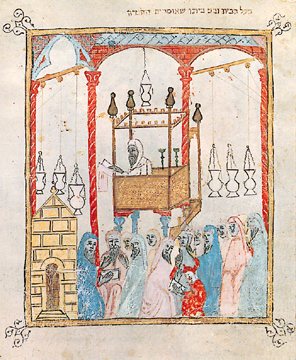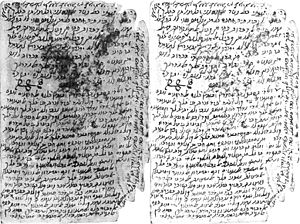Golden age of Jewish culture in Spain facts for kids
The Golden Age of Jewish culture in Spain was a special time in history. It happened during the Middle Ages in Europe. During this period, much of Spain was under Muslim rule, known as Al-Andalus. Jews were generally accepted in society, and their religious, cultural, and economic life really blossomed.
Historians debate exactly when this "Golden Age" started and ended. Some say it began around 711–718, when Muslims conquered Spain. Others point to 912, during the rule of Abd al-Rahman III. The end is also debated, with dates ranging from 1031 (when the Caliphate of Córdoba ended) to the mid-12th century (when the Almohads invaded).
Contents
A Time of Learning and Growth

After Muslim rulers took over southern Spain, they faced questions about how to govern a society with many non-Muslims. Many writers praise the way Muslims, Jews, and Christians lived together during this time. Al-Andalus became a very important center for Jewish life in the early Middle Ages. It was seen as a "capital" for Jewish people worldwide.
Some historians, like María Rosa Menocal, believe that being accepting of different cultures was a key part of society in Al-Andalus. She suggests that Jewish people, while having fewer rights than Muslims, were still better off than Jews in Christian parts of Europe. Jews from other places even moved to Al-Andalus. Here, they could practice their faith and trades freely, as long as they didn't try to convert others or build new synagogues too openly.
However, not all historians agree. Bernard Lewis argues that Islamic societies didn't promise full equality. Still, he notes that Jewish people were generally allowed to practice their religion and follow their own laws. The rules they faced were more about showing the difference between communities, rather than truly oppressing them.
Mark R. Cohen calls the idea of a perfect, tolerant society a "myth." He says this idea was first spread by Jewish historians in the 1800s to criticize how Christian countries treated Jews. He also says that the opposite idea – that Jewish-Arab history was always sad – is also not fully true. History is often more complex.
How the Golden Age Began
Before 589, the Jewish people in Spain were generally accepted by their Visigoth rulers. They had equal standing with other groups. But after the Visigoths became Catholic, they started to put more burdens on the Jewish population and later treated them harshly. Because of this, some Jewish people may have welcomed the Muslim conquerors in the 8th century.
A period of greater tolerance began for the Jews in Spain. Many Jews from North Africa moved to Muslim Spain, making it a large center for Jewish life. Especially after 912, during the rule of Abd al-Rahman III and his son, Al-Hakam II, Jewish people thrived culturally. Some important Jewish figures even held high positions in the government.
Jewish thinkers, mathematicians, astronomers, poets, and religious scholars created amazing cultural and scientific works. Many focused on science and philosophy, writing valuable texts on Jewish philosophy. Jews were part of the general success of Muslim Al-Andalus. Their economic growth was remarkable. In Toledo, after Christians took it back in 1085, Jews helped translate Arabic texts into local languages. They had also helped translate Greek and Hebrew texts into Arabic before. Jews also contributed to areas like botany, geography, medicine, and poetry.
Hasdai ibn Shaprut, a Jewish physician and minister, worked for 'Abd al-Rahman. He supported other Jewish scholars and poets. In later centuries, Jewish thought continued to flourish with famous people like Samuel Ha-Nagid, Moses ibn Ezra, Solomon ibn Gabirol, and Judah Halevi. During 'Abd al-Rahman's time, the scholar Moses ben Hanoch became the main rabbi of Córdoba. This made Al-Andalus a center for studying the Talmud, a key Jewish religious text.
Jewish people had some self-rule. They were considered "dhimmis" or "protected non-Muslims" in the Islamic world. This meant they paid a special tax called jizya. This tax was different from the tax Muslims paid. The jizya was seen as a tax for not serving in the military or as a form of tribute. Jews had their own legal system and social services. Monotheistic religions like Judaism were tolerated, but showing their faith too openly, like with loud bells or parades, was discouraged.
Compared to how Jews were treated in Christian Europe during the Middle Ages, Jews in the Islamic world were much more involved in political and economic life. They usually faced less violence from Muslims. However, there were still times of hardship in the Islamic world starting from the 11th century.
Some authors criticize the idea that Al-Andalus was a perfectly tolerant society for all religions. They argue that Jews, Muslims, and Catholics lived together in a difficult way, often with separation and dislike. For example, in the 1066 Granada massacre, many Jewish people in the city were killed. The famous Jewish philosopher Moses Maimonides (1135–1204) had to leave Al-Andalus to avoid being forced to convert by the Almohads. He wrote about the challenges faced by Jewish people during that time.
The End of the Golden Age
After Al-Hakam II died in 976, the caliphate (the Muslim government) began to break apart. This made the situation for Jewish people less secure. The first major attack was the 1066 Granada massacre. On December 30, a Muslim crowd attacked the royal palace in Granada. They killed the Jewish minister Joseph ibn Naghrela and many other Jewish people in the city. One source says that over 1,500 Jewish families, totaling 4,000 people, died in one day. This was the first major attack on Jews in Spain under Muslim rule.

Starting in 1090, things got even worse with the invasion of the Almoravids. They were a strict Muslim group from Morocco. Even under the Almoravids, some Jews still did well, especially under Ali III. But the Almoravids were pushed out in 1148. Then, another even stricter group, the Almohads, invaded.
During the rule of these new groups, many Jewish and even Muslim scholars left the Muslim-controlled parts of Spain. They moved to the city of Toledo, which Christian forces had taken back in 1085.
A large Jewish presence continued in Spain until 1492. In that year, the Alhambra Decree forced Jews to leave Spain or convert to Christianity. A similar order was given in Portugal in 1496.
Important People from the Golden Age
- Bahya ibn Paquda: A philosopher and author.
- Dunash ben Labrat (920–990): A poet.
- Hasdai ibn Shaprut: A royal physician and important government official.
- Ibrahim ibn Yaqub: A traveler and merchant.
- Isaac Albalia: An astronomer and rabbi.
- Joseph ibn Naghrillah: A king's minister.
- Judah Halevi: A famous poet and philosopher.
- Maimonides: One of the greatest Jewish scholars, a rabbi, philosopher, and doctor. He wrote important books like Mishnah Torah.
- Moses ben Enoch: A rabbi and scholar of the Talmud.
- Moses ibn Ezra: A philosopher and poet.
- Nachmanides: A scholar, rabbi, philosopher, and doctor.
- Samuel ha-Levi: The treasurer for King Pedro I of Castile.
- Samuel ibn Naghrillah: A king's minister and poet.
- Solomon ibn Gabirol: A poet and philosopher.
- Yehuda Halevi: A poet and philosopher.
Images for kids
-
Jewish Street (Toledo, Spain)
See also
 In Spanish: Edad de oro de la cultura judía en al-Ándalus para niños
In Spanish: Edad de oro de la cultura judía en al-Ándalus para niños
- Al-Andalus
- History of the Jews in Spain
- History of the Jews in Portugal
- Reconquista
- Sephardic Jews under Islam


